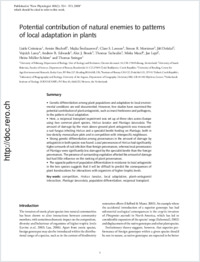Potential contribution of natural enemies to patterns of local adaptation in plants
- Crémieux, Lisèle University of Fribourg, Department of Biology, Unit of Ecology and Evolution, Switzerland
- Bischoff, Armin University of Fribourg, Department of Biology, Unit of Ecology and Evolution, Switzerland
- Šmilauerová, Majka University of South Bohemia, Faculty of Science, Department of Botany, České Budějovice, Czech Republic
- Lawson, Clare S. University of Reading, Centre for Agri-Environmental Research, Reading, UK
- Mortimer, Simon R. University of Reading, Centre for Agri-Environmental Research, Reading, UK
- Doležal, Jiří University of South Bohemia, Faculty of Science, Department of Botany, České Budějovice, Czech Republic
- Lanta, Vojtěch Institute of Botany CAS CZ, Třeboň, Czech Republic
- Edwards, Andrew R. University of Reading, Centre for Agri-Environmental Research, Reading, UK
- Brook, Alex J. University of Reading, Centre for Agri-Environmental Research, Reading, UK
- Tscheulin, Thomas Laboratory of Biogeography and Ecology, University of the Aegean, Department of Geography, University Hill, Mytilene, Greece
- Macel, Mirka Netherlands Institute of Ecology, Heteren, the Netherlands
- Lepš, Jan University of South Bohemia, Faculty of Science, Department of Botany, České Budějovice, Czech Republic
- Müller-Schärer, Heinz University of Fribourg, Department of Biology, Unit of Ecology and Evolution, Switzerland
- Steinger, Thomas University of Fribourg, Department of Biology, Unit of Ecology and Evolution, Switzerland
-
08.07.2008
Published in:
- New Phytologist. - 2008, vol. 180, no. 2, p. 524 - 533
Competition
Holcus lanatus
Local adaptation
Plant-antagonist interaction
Plantago lanceolata
Population differentiation
Reciprocal transplant
English
Genetic differentiation among plant populations and adaptation to local environmental conditions are well documented. However, few studies have examined the potential contribution of plant antagonists, such as insect herbivores and pathogens, to the pattern of local adaptation.Here, a reciprocal transplant experiment was set up at three sites across Europe using two common plant species, Holcus lanatus and Plantago lanceolata. The amount of damage by the main above-ground plant antagonists was measured: a rust fungus infecting Holcus and a specialist beetle feeding on Plantago, both in low-density monoculture plots and in competition with interspecific neighbours. Strong genetic differentiation among provenances in the amount of damage by antagonists in both species was found. Local provenances of Holcus had significantly higher amounts of rust infection than foreign provenances, whereas local provenances of Plantago were significantly less damaged by the specialist beetle than the foreign provenances. The presence of surrounding vegetation affected the amount of damage but had little influence on the ranking of plant provenances. The opposite pattern of population differentiation in resistance to local antagonists in the two species suggests that it will be difficult to predict the consequences of plant translocations for interactions with organisms of higher trophic levels.
- Faculty
- Faculté des sciences et de médecine
- Department
- Département de Biologie
- Language
-
- English
- Classification
- Biological sciences
- License
-
License undefined
- Identifiers
-
- RERO DOC 11258
- DOI 10.1111/j.1469-8137.2008.02545.x
- Persistent URL
- https://folia.unifr.ch/unifr/documents/301026
Statistics
Document views: 193
File downloads:
- pdf: 249
